p.36
p.40
p.44
p.48
p.54
p.60
p.66
p.71
p.77
Particle Swarm Optimization Using Various Inertia Factor Variants
Abstract:
This paper presents an alternative and efficient method for solving the optimal control of manufacturing systems. Three different inertia factor, a constant inertia factor (CIF), time-varying inertia factor (TVIF), and global-local best inertia factor (GLbestIF), are considered with the particle swarm optimization(PSO) algorithm to analyze the impact of inertia factor on the performance of PSO algorithm. The PSO algorithm is simulated individually with the three inertia factor separately to compute the optimal control of the manufacturing system, and it is observed that the PSO with the proposed inertia factor yields better resultin terms of both optimal solution and faster convergence. Several statistical analyses are carried out from which can be concluded that the proposed method is superior to all the other methods considered in this paper.
Info:
Periodical:
Pages:
54-59
Citation:
Online since:
January 2011
Authors:
Price:
Сopyright:
© 2011 Trans Tech Publications Ltd. All Rights Reserved
Share:
Citation:


